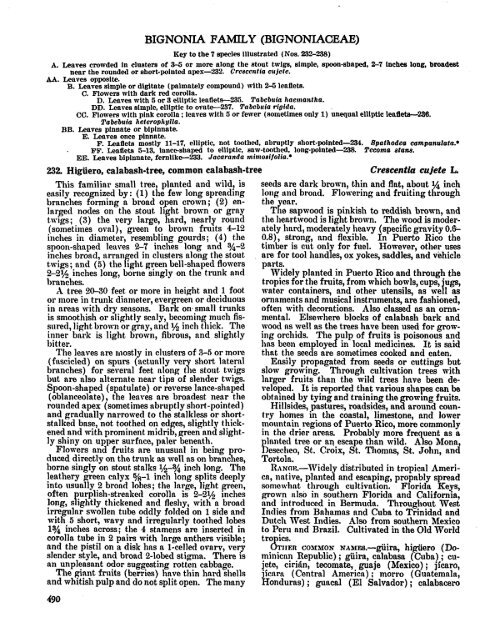Common Trees of Puerto Rico and the Virgin Islands
Common Trees of Puerto Rico and the Virgin Islands
Common Trees of Puerto Rico and the Virgin Islands
You also want an ePaper? Increase the reach of your titles
YUMPU automatically turns print PDFs into web optimized ePapers that Google loves.
BIGNONIA FAMILY (BIGNONLACEAE)<br />
Key to <strong>the</strong> 7 species illustrated (Nos. 232-238)<br />
A. Leaves crowded in clusters <strong>of</strong> 3-5 or more along tlie stout twiga, simple, epoon-shaped, 2-7 inches long, broadest<br />
near <strong>the</strong> rounded or shorbpolnted npex-232. Crcaccntia oufele.<br />
AA. Leaves opposite.<br />
B. Leaves simple or digitate (pnlmntely compound) with 2-C, leaflets.<br />
C. Flowers with dark red corolln.<br />
D. Leaves with 6 or 3 elliptic leaflets-235. Tabebuta i~aeniawtha.<br />
DD. Leaves slmple, elllptic to ovate-237. Tabebuia rfgida.<br />
CC. Flowers with pink corolln ; leaves with Ei or fewer (sometimes only 1) unequal elllptlc leaflets-256.<br />
Tabebuia lreteropl~~lla.<br />
BB. Leaves plnnate or biplnnnte.<br />
E. Lenves once pinnate.<br />
F. Leaflets mostly 11-17, elliptic, not too<strong>the</strong>d, nbruptly short-pointed-234. Rpathodea campanulata.*<br />
FF. Leaflets 5-13, lnncct-shaped to elliptic, saw-too<strong>the</strong>d, long-pointed-238. Tecoma scans.<br />
EE. Leaves biplnnnte, fernlike-233. Jacar<strong>and</strong>a minroeifolia.*<br />
232. Higiiero, calabash-tree, common calabash-tree Crescentia cujete L<br />
This familiar small tree, planted <strong>and</strong> wild, is seecls are dark brown, thin <strong>and</strong> flat, about 1/4 inch<br />
etisily recognized by : (1) <strong>the</strong> few long spreading long cind broad. Flowering <strong>and</strong> fruiting through<br />
brnnches forming a broad open crown; (2) en- <strong>the</strong> ear.<br />
Inrged nodes on <strong>the</strong> stout 11 ht bmwn or gray ~ isapwood e is pinkish to reddish bmwn, <strong>and</strong><br />
twigs; (3) <strong>the</strong> very large, Rard, nearly round tlie henrt,vood is light bmwn. The wood is moder-<br />
(sometimes ovnl), green to brown fruits 4-12 tltely hard, moderately heavy (specific gravity 0.6<br />
inches in diameter, resembling gourds; (4) tlie 0.8), strong, nnd flexible. In <strong>Puerto</strong> <strong>Rico</strong> <strong>the</strong><br />
spoon-shaped leaves 2-7 inches long <strong>and</strong> 3/q-2 t.imber is cut only for fuel. However, o<strong>the</strong>r uses<br />
inches brond, lurrnn ed in clusters along <strong>the</strong> stout are for tool h<strong>and</strong>les, ox yokes, saddles, <strong>and</strong> vehicle<br />
twigs; <strong>and</strong> (5) <strong>the</strong> f&l\t green bell-shaped flowers parts.<br />
Z21/2 inches long, borne singly on <strong>the</strong> trunk <strong>and</strong> Widely planted in <strong>Puerto</strong> <strong>Rico</strong> <strong>and</strong> through <strong>the</strong><br />
branches. tropics for <strong>the</strong> fruits, from which bowls, cups, jugs,<br />
A tree 2030 feet or mot= in height <strong>and</strong> 1 foot water containers, <strong>and</strong> o<strong>the</strong>r utensils, as well as<br />
or more in trunk diameter, evergreen or deciduous ol+nnments <strong>and</strong> musical instruments, are fashioned,<br />
in areas with dry seasons. Bark on-small trunks <strong>of</strong>ten with decorations. Also classed ns an orna-<br />
is smoothish or slightly scaly, becoming much fis- mental. Elsewhere blocks <strong>of</strong> calabash bark <strong>and</strong><br />
sured, light brown or grny, <strong>and</strong> 1/2 inch thick. Tho wood ns well ns <strong>the</strong> trees have been used for grow-<br />
inner bnrk is light brown, fibrous, <strong>and</strong> slightly ing orchids. The ulp <strong>of</strong> fruits is poisonous <strong>and</strong><br />
bitter. ]ins been employe c f in local medicines. It is said<br />
The leaves are rrlostly in clusters <strong>of</strong> 3-5 or more that <strong>the</strong> seeds are sometimes cooked <strong>and</strong> eaten.<br />
(fnscicled) on spurs (nctunlly ve short Intern1 Ensily propagnted from seeds or cuttings but<br />
brnnches) for severnl feet dong 7 t le stout twigs slow growing. Through cultivation trees with<br />
but are also alternate near tips <strong>of</strong> slender twigs. larger fruits than <strong>the</strong> wild trees have been de-<br />
Spoon-shaped (s atulate) or reverse lnnce-shaped veloped. It is reported that various shapes can be<br />
(oblnnceolate), t y ie leaves are broadest near <strong>the</strong> obtained by tying <strong>and</strong> training <strong>the</strong><br />
rounded apes (sometimes ttbruptly short-pointed) Hillsides, .pastures, roadsides, an Twmg<br />
around fruits. coun<strong>and</strong><br />
grndually narrowed to <strong>the</strong> stalkless or short- try homes In <strong>the</strong> coastal, limestone, <strong>and</strong> lower<br />
stalked base, not too<strong>the</strong>d on ed es, slightly thick- mountain regions <strong>of</strong> <strong>Puerto</strong> <strong>Rico</strong>, more commonly<br />
ened <strong>and</strong> with prominent midrif, green <strong>and</strong> slight- in <strong>the</strong> drier areas. Probably more fre uent as a<br />
ly shiny on upper surface, paler beneath. lnnted tree or an esca e than mild. A 9 so Mona<br />
Flowers <strong>and</strong> fruits are unusual in being - Aesec~eo, St. Croix,<br />
Y<br />
&. Thomns, St. John, <strong>and</strong><br />
duced directly on <strong>the</strong> trunk ns well as on bmnc les, Tortoln.<br />
borne singly on stout stalks I,+% inch long. The Rdz~cr~.-lVidelg distributed in tropical Amerilea<strong>the</strong>ry<br />
green calyx %-I inch long splits deeply ca, native, planted <strong>and</strong> escaping, propably spread<br />
into lisually 2 brond lobes; <strong>the</strong> large, light green, somotvhat through cultivntion. Florida Keys,<br />
<strong>of</strong>ten urplish-streaked corolln is 2-2% Inches grown tilso in sou<strong>the</strong>rn Florida <strong>and</strong> California,<br />
long, sEghtly thickened nnd fleshy, with a brond <strong>and</strong> introduced in Bermuda. Throughout West<br />
irregular swollen tube oddly folded on 1 side <strong>and</strong> Indies from Bahamas <strong>and</strong> Cuba to Trinidad <strong>and</strong><br />
wit11 5 short, wavy <strong>and</strong> irregularly too<strong>the</strong>d lobes Dutch West Indies. Also from sou<strong>the</strong>rn Mexico<br />
1% inches across; <strong>the</strong> 4 stamens are inserted in to Peru <strong>and</strong> Brazil. Cultivated in <strong>the</strong> Old World<br />
corolla tube in 2 pairs with large an<strong>the</strong>rs visible; tro ics.<br />
<strong>and</strong> <strong>the</strong> pistil on a disk has a 1-celled ovary, very ~TIIEII COXYON ~~t~m.-giiirtt, higiiero (DOslender<br />
style, <strong>and</strong> broad 2-lobed stigmn. There is minicnn Republic) ; @im, calabasa (Cuba) ; cuan<br />
unpleasant odor suggesting rotten cabbage. jete, ciridn, twomate,. guaje (Mexico) ; jicaro,<br />
The giant fruits (berries) have thin hard shells jicnrn (Central Amer~ca) ; morro (Guatemala,<br />
<strong>and</strong> whitish pulp <strong>and</strong> do not split open. The many Honduras) ; guacal (El Salvador) ; calabawro

















